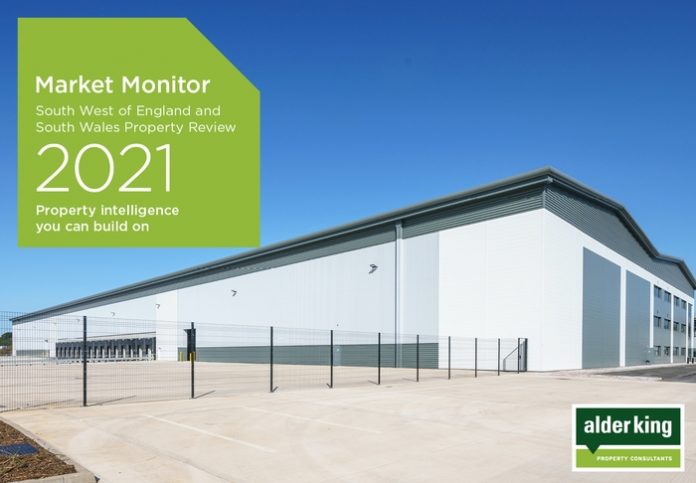The industrial/logistics sector was the driving force behind the South West’s commercial property market last year, recording annual take-up of over 6.3 million sq ft, up from 4.2 million sq ft in 2019. This is the sector’s highest figure since 2016, says property consultancy Alder King in its newly published report Market Monitor, and all the more remarkable given the circumstances of the year.
The sector’s performance was driven by continuing demand for e-commerce, government investment in infrastructure and businesses safeguarding against Brexit through the repatriation of manufacturing and stockpiling of goods. The logistics sector, particularly internet fulfilment, and manufacturers/added value engineering occupiers also contributed to the demand. Significant transactions last year included Amazon’s 2.3 million sq ft robotic logistics centre at Symmetry Park in Swindon and Bart Spices and Wincanton/EDF’s acquisitions in Avonmouth and Portbury. Gloucestershire saw higher than average take-up for manufacturing space while in Exeter, Stovax committed to a 190,000 sq ft manufacturing facility at SkyPark.
Simon Price, Alder King’s senior partner, said: “After a year that threw up a host of questions for the property market, it’s remarkable how resilient some sectors of the market were in 2020. And although as we begin 2021 the situation still remains unsettled, there are a number of positive market opportunities for developers, landlords, investors and occupiers, making us optimistic of further activity later in the year.”
The strength of the regional industrial/logistics sector is best illustrated regionally by Greater Bristol which registered 2.2 million sq ft of industrial take-up, a 55% increase from that in 2019, and other regional centres would also have reported stronger take-up if it were not for a lack of immediately available space. Looking ahead, with the majority of South West centres supporting speculative development, there is strong potential for developers to secure pre-lets and pre-sales, leading to improved rentals, lease durations and capital values.
For some industrial occupiers, affordability will be an issue as the rental gap between new and good quality second hand space has reduced significantly. This will lead to further upward pressure on industrial rents, particularly for those facing their first rent reviews on space acquired since 2015.
While the office sector was clearly hit by the pandemic, the South West still recorded a positive 1.4 million sq ft of take-up in 2020. The Bristol office market secured 764,000 sq ft of take-up, boosted by a very strong Q1 and an encouraging Q4 which saw the completion of several deals which had been negotiated in late summer following the end of the first lockdown.
After the move to remote working during the pandemic, many office occupiers are set to review their requirements during the first half of this year, with a common theme being a move towards slightly less (10-20%) space but of a higher quality. However the ongoing loss of office space for residential conversion and limited amount of new build space in most markets should outweigh any increase in second hand supply.
Investors, as always in turbulent times, were drawn in a general flight to quality, showing strong demand for industrial logistics, prime offices and other secure income assets in the south west. The overall volume of investment transactions was down on 2019 in all South West locations but there is a significant weight of money looking for attractive returns and with greater certainty later this year, investors will be ready to return. We also expect a quick rebound in the buy to let, purpose-built student accommodation and other alternative sectors.
The pandemic accelerated on-going change in the retail and leisure sectors. However with a relaxation in planning policy and strong pent-up demand from consumers, the opportunity does exist for high streets to incorporate more independent retail – which on the whole survived better than the large chains – as well as a wider mix of uses which will include residential, leisure, workspace and civic amenities.
Simon Price concluded: “After a year like no other, we start 2021 with a Brexit trade deal in place and a Covid vaccination programme underway and are optimistic of a sustained bounce-back in most sectors of the market from the second quarter of the year.”















